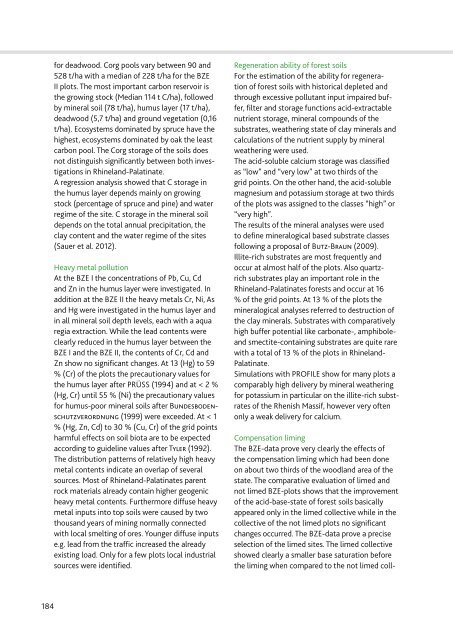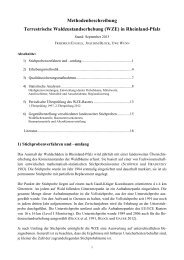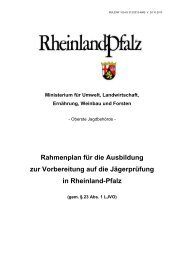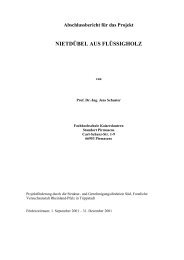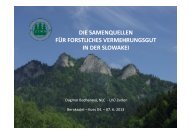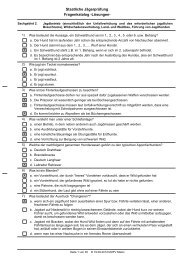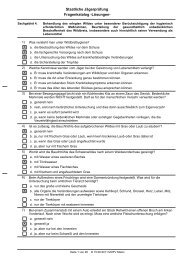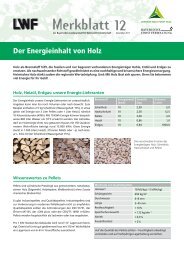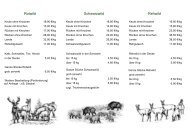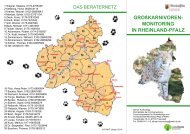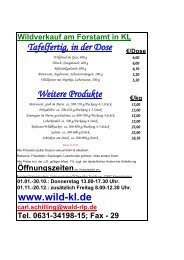Zentralstelle der Forstverwaltung - Landesforsten Rheinland-Pfalz
Zentralstelle der Forstverwaltung - Landesforsten Rheinland-Pfalz
Zentralstelle der Forstverwaltung - Landesforsten Rheinland-Pfalz
Sie wollen auch ein ePaper? Erhöhen Sie die Reichweite Ihrer Titel.
YUMPU macht aus Druck-PDFs automatisch weboptimierte ePaper, die Google liebt.
184<br />
for deadwood. Corg pools vary between 90 and<br />
528 t/ha with a median of 228 t/ha for the bze<br />
ii plots. the most important carbon reservoir is<br />
the growing stock (Median 114 t C/ha), followed<br />
by mineral soil (78 t/ha), humus layer (17 t/ha),<br />
deadwood (5,7 t/ha) and ground vegetation (0,16<br />
t/ha). ecosystems dominated by spruce have the<br />
highest, ecosystems dominated by oak the least<br />
carbon pool. the Corg storage of the soils does<br />
not distinguish significantly between both investigations<br />
in Rhineland-Palatinate.<br />
a regression analysis showed that C storage in<br />
the humus layer depends mainly on growing<br />
stock (percentage of spruce and pine) and water<br />
regime of the site. C storage in the mineral soil<br />
depends on the total annual precipitation, the<br />
clay content and the water regime of the sites<br />
(sauer et al. 2012).<br />
heavy metal pollution<br />
at the bze i the concentrations of Pb, Cu, Cd<br />
and zn in the humus layer were investigated. in<br />
addition at the bze ii the heavy metals Cr, ni, as<br />
and hg were investigated in the humus layer and<br />
in all mineral soil depth levels, each with a aqua<br />
regia extraction. While the lead contents were<br />
clearly reduced in the humus layer between the<br />
bze i and the bze ii, the contents of Cr, Cd and<br />
zn show no significant changes. at 13 (hg) to 59<br />
% (Cr) of the plots the precautionary values for<br />
the humus layer after PRÜss (1994) and at < 2 %<br />
(hg, Cr) until 55 % (ni) the precautionary values<br />
for humus-poor mineral soils after bundesbodenschutzverordnung<br />
(1999) were exceeded. at < 1<br />
% (hg, zn, Cd) to 30 % (Cu, Cr) of the grid points<br />
harmful effects on soil biota are to be expected<br />
according to guideline values after tyler (1992).<br />
the distribution patterns of relatively high heavy<br />
metal contents indicate an overlap of several<br />
sources. Most of Rhineland-Palatinates parent<br />
rock materials already contain higher geogenic<br />
heavy metal contents. furthermore diffuse heavy<br />
metal inputs into top soils were caused by two<br />
thousand years of mining normally connected<br />
with local smelting of ores. Younger diffuse inputs<br />
e.g. lead from the traffic increased the already<br />
existing load. only for a few plots local industrial<br />
sources were identified.<br />
Regeneration ability of forest soils<br />
for the estimation of the ability for regeneration<br />
of forest soils with historical depleted and<br />
through excessive pollutant input impaired buffer,<br />
filter and storage functions acid-extractable<br />
nutrient storage, mineral compounds of the<br />
substrates, weathering state of clay minerals and<br />
calculations of the nutrient supply by mineral<br />
weathering were used.<br />
the acid-soluble calcium storage was classified<br />
as “low” and “very low” at two thirds of the<br />
grid points. on the other hand, the acid-soluble<br />
magnesium and potassium storage at two thirds<br />
of the plots was assigned to the classes “high” or<br />
“very high”.<br />
the results of the mineral analyses were used<br />
to define mineralogical based substrate classes<br />
following a proposal of butz-braun (2009).<br />
illite-rich substrates are most frequently and<br />
occur at almost half of the plots. also quartzrich<br />
substrates play an important role in the<br />
Rhineland-Palatinates forests and occur at 16<br />
% of the grid points. at 13 % of the plots the<br />
mineralogical analyses referred to destruction of<br />
the clay minerals. substrates with comparatively<br />
high buffer potential like carbonate-, amphibole-<br />
and smectite-containing substrates are quite rare<br />
with a total of 13 % of the plots in Rhineland-<br />
Palatinate.<br />
simulations with PRofile show for many plots a<br />
comparably high delivery by mineral weathering<br />
for potassium in particular on the illite-rich substrates<br />
of the Rhenish Massif, however very often<br />
only a weak delivery for calcium.<br />
Compensation liming<br />
the bze-data prove very clearly the effects of<br />
the compensation liming which had been done<br />
on about two thirds of the woodland area of the<br />
state. the comparative evaluation of limed and<br />
not limed bze-plots shows that the improvement<br />
of the acid-base-state of forest soils basically<br />
appeared only in the limed collective while in the<br />
collective of the not limed plots no significant<br />
changes occurred. the bze-data prove a precise<br />
selection of the limed sites. the limed collective<br />
showed clearly a smaller base saturation before<br />
the liming when compared to the not limed coll-


